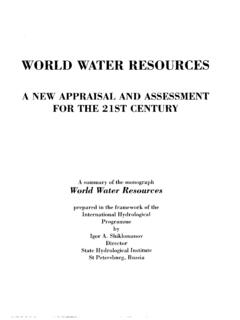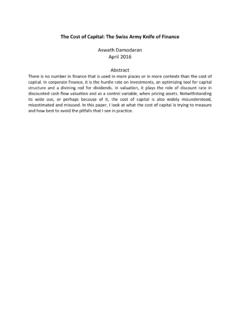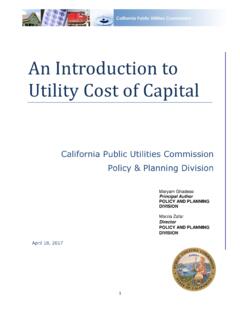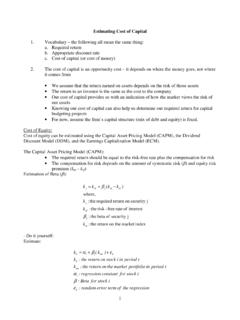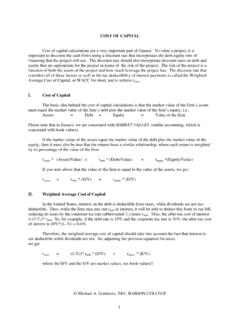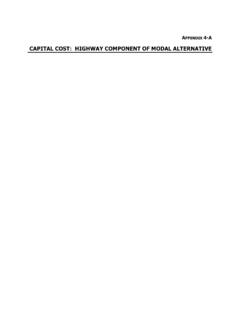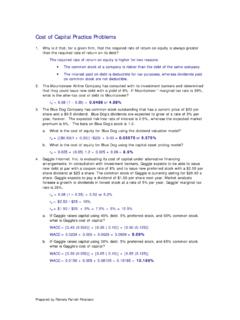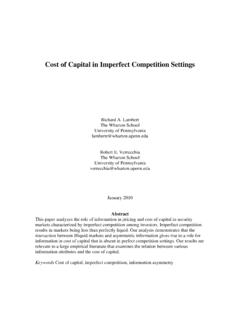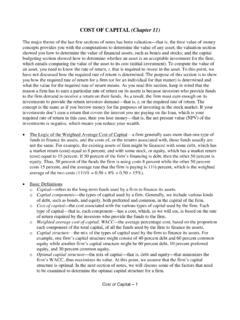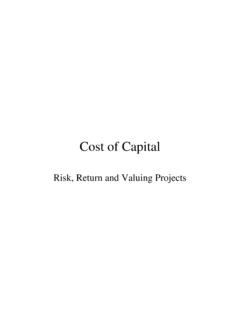Transcription of Financial Benefit-Cost Analysis
1 CHAPTER 5 Financial Benefit-Cost Analysis HANDBOOK FOR THE ECONOMIC Analysis OF WATER SUPPLY Operations and Residual Financial Financial Opportunity cost of capital andWeighted Average cost of the Weighted Average cost of Financial IRR and Estimation of Project Revenues (1996 Prices)..125 Table Project cost 128 Table Net Financial 130 Table Sample Calculation of Weighted Average cost of 132 Table Estimation of FIRR and FNPV (in Million VND, 1996 Prices).. 134 CHAPTER 5: Financial Benefit-Cost Analysis purpose of the Financial Benefit-Cost Analysis is to assess thefinancial viability of the proposed project, , if the proposed project is financiallyattractive or not from the entity s viewpoint. This Analysis is done for the chosen least- cost alternative which is identified following methodology described in Chapter the Financial Benefit-Cost Analysis , the unit of Analysis is the project andnot the entire economy nor the entire water utility.
2 Therefore, a focus on the additionalfinancial benefits and costs to the water utility, attributable to the project, is contrast, the economic Benefit-Cost Analysis evaluates the project from the viewpointof the entire economy whereas the Financial Analysis evaluates the entire water utility byproviding projected balance, income, and sources and applications of fund Analysis is the subject of the ADB Guidelines on the Financial Analysis of Financial Benefit-Cost Analysis includes the following eight steps:(i)determine annual project revenues;(ii)determine project costs;(iii)calculate annual project net benefits ;(iv)determine the appropriate discount rate ( , weighted average cost ofcapital serving as proxy for the Financial opportunity cost of capital );(v)calculate the average incremental Financial cost ;(vi)calculate the Financial net present value;(vii) calculate the Financial internal rate of return; and(viii) risk and sensitivity revenues, costs and net benefits are determined on a with-projectand without-project basis.
3 They are estimated in constant prices for a selected year ( ,constant 1998 prices), typically using the official exchange rate at appraisal. The revenuesof the project comprise of entirely user charges, that is, no government subsidies areincluded. HANDBOOK FOR THE ECONOMIC Analysis OF WATER SUPPLY focus of the Financial Benefit-Cost Analysis is on the financialbenefits and costs of the project intervention. Hence, the project s water sales revenuesare determined on a with-project and without-project basis. In this way, thecontribution of the project to the total revenues of the utility is project revenues are usually determined for different groups ofusers, such as households, government institutions and private commercial/industrialestablishments. Each may have a different consumption pattern, may be charged adifferent tariff and may respond differently to tariff increases.
4 These price-quantityrelationships are part of the demand forecast presented in Chapter illustrates the calculation of project revenues. In the example,the existing water supply system has reached its maximum supply capacity. It has beenassumed that, without the project, the system will be properly maintained and operatedso that the present volume and quality of water supply can be maintained in the the project, the water supply system will be extended to supply (increasedquantities of) water to existing as well as new consumers. The project water supply andrevenues are determined as the difference between the with-project and the without-project 5: Financial Benefit-Cost Analysis 125 Table Estimation of Project Revenues (1996 prices)unit1996199719981999200020051 Domestic consumers2 Water supplied with-project 000 m 1,2391,5181,8642,2892,8193,9543 Water supplied without-project 000 m 1,2391,2391,2391,2391,2391,2394 Project water supply 000 m 02796251,0501,5802,7155 Average tariffVND/m 2,2202,3942,5812,7823,0004,5006 Project revenuesVND mn06681,6132,9224,74012,2177 Government establishments8 Water supplied with-project 000 m 2933003083153244549 Water supplied without-project 000 m 29329329329329329310 Project water supply 000 m 0715223116111 Average tariffVND/m 2,8003,0613,3473,6594,0004,50012 Project revenuesVND mn021508012472613 Private establishments14 Water supplied with-project 000 m 33233934835636651315 Water supplied without-project 000 m 33233233233233233216 Project water supply 000 m 0716243418117 Average tariffVND/m 4,5004,6204,7434,8705,0005.
5 50018 Project revenuesVND mn0327611717099719 Subtotal water revenues20 Total project water revenuesVND mn07221,7393,1195,03413,94021 Total project water supply 000 m 02936561,0961,6453,05822 Connection fees23 Average connection fee 000 VND1,5001,5001,5001,5001,5001,50024 New connections with-projectnumber01,7012,0452,4592,9570 25 New connections without-projectnumber00000026 Additional connectionsnumber01,7012,0452,4592,95702 7 Project connection feesVND mn02,5523,0683,6894,436028 Total project revenuesVND mn03,2734,8076,8079,47013,940 Note: Years 2001-2004 are not shown in this example. HANDBOOK FOR THE ECONOMIC Analysis OF WATER SUPPLY average tariff presented in constant 1996 prices as shown in , was projected to increase significantly with the implementation of the project, toachieve a higher level of cost recovery, as follows (VND/m ):Year ---------------------------------------- --------consumers 1996 2000 2005domestic2,2203,0004,500government2,8 004,0004,500private4,5005,0005, tariff proposal took into account the ability to pay of domesticconsumers and involves some degree of cross-subsidization between domestic and non-domestic water demand forecast used for illustrative purposes includes theeffect of price as well as real per capita income increases on demand.
6 Overall increase inwater demand will mainly result from new domestic consumers connected to the newwater system project, as shown in Table the least- cost alternative has been selected, the preliminary projectcost estimates are typically worked out in greater detail by the engineer. The followingmain categories are distinguished:(i)investments;(ii)operati on and maintenance; and(iii)re-investments during the life , the costs should be attributed to the project on a with-projectand without- project basis. Only the additional costs due to the project should be takeninto account. The basis to attribute costs to the project should be the formulated with-project and without-project scenarios. In Section for example, it was assumed thatwithout the project, the existing water supply would be properly maintained andoperated, and that the present level of services would continue if the project were notimplemented.
7 The project costs should be calculated on an annual basis and should beequal to the with-project costs less the without-project costs. It should also be notedthat in many cases the system would deteriorate further in the without-project 5: Financial Benefit-Cost Analysis breakdown of an investment cost estimate of total US$ million(including IDC) is shown in Table where foreign and local currency componentswere distinguished to establish the foreign exchange implications of the project andcounterpart financing requirements. Following the general principles of discountingaccording to which costs and benefits are entered in the Analysis in the year in whichthey occur, interest during construction (IDC) is excluded from the costs used in thefinancial Benefit-Cost Analysis .
8 HANDBOOK FOR THE ECONOMIC Analysis OF WATER SUPPLY PROJECTS128 Table Project cost Estimates a / ($ million) ForeignLocal b/ TotalComponent CurrencyA. WATER - Works-Drilling of Wells by Contractors Works by Contractors Works by WDs of Equipment-Pipes and Fittings and Motors Meters Equipment Materials and Construction Managementby Administration - (A) EDUC & WATER and Hygiene Education Program - Quality Testing for Staff and Conduct of Testing - Works - of Equipment- Equipment for Water AnalysisLaboratories Chemicals and Reagents Portable Water Analysis Kits - (B)
9 Program-Training of Water Districts Staff - s Project Management Staff Monitoring and Evaluation - Services (C) DURING August 1996 price levelb/ Local cost includes duties and taxes estimated at $ million equivalent or 10% of civilworks, equipment, materials and consulting 5: Financial Benefit-Cost Analysis and of operation and maintenance (O&M) costs are usuallyprovided to the economist by the engineer or Financial analyst. In practice, differentways of estimating O&M costs are used. One approach is to estimate the O&M costs asa percentage of (accumulated) investment costs. Another approach might be to analyzethe utility s past performance and to relate the total O&M costs to the volume of waterproduced and/or distributed.
10 And a third approach relates specific costs items tospecific outputs and totals them in a second step. For example, costs of electricity andchemicals could be calculated on the basis of a specific requirement per m producedand the labor requirements could be calculated on the basis of the number of employeesper elements of O&M costs may include: labor; electricity; chemicals; materials; overhead; raw water charges; insurance; project investment assets have different lifetimes and needreplacement within the project lifetime. The cost of those reinvestments needs to beincluded in the project s Benefit-Cost residual value of project assets at the end of the project life shouldbe included in the Benefit-Cost Analysis as a negative cost (or benefit).




